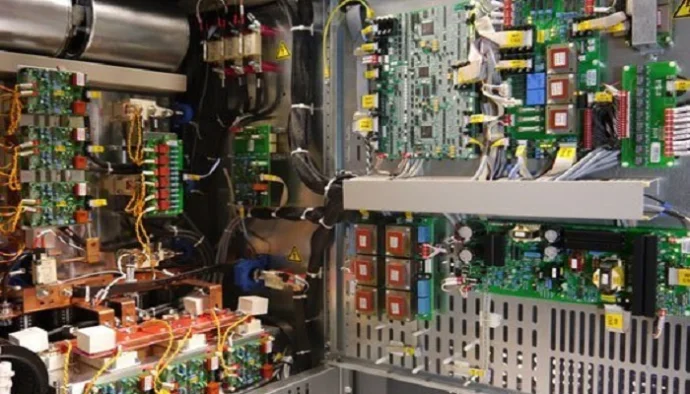How To Improve the Energy Efficiency of Datacentre UPS
Energy efficiency is a key metric within server rooms and datacentres. For many colocation and hyperscale datacentres, monitoring how efficiently energy is used is as much about benchmarking as it about reducing electricity bills.
Server room and datacentre hardware manufacturers continue to invest in and develop the energy efficiency of their systems. Whether it is a cooling system or uninterruptible power supply, substantial improvements can be made through refurbishing existing installation and selecting the most energy efficient configurations for new builds and applications.
Modern Energy Efficient UPS Systems
IEC 62040-3 is the international standard for specifying and measuring the performance of uninterruptible power supplies. The standard classifies UPS into three topologies including: offline/standby, line interactive and online modes of operation.
Online UPS systems provide the ultimate power protection and have a constantly running inverter powering the load with a digitally generated sinewave. A built-in automatic bypass provides safe-failure-to-mains if the UPS is overloaded or develops a fault condition. Monoblock online UPS systems can be transformer-based or transformer-less in design.
Transformer-based UPS systems were traditionally considered the more robust of the two designs and have a transformer connected rectifier input. The transformer provides galvanic isolation which is a separation of the input and output UPS supplies and protects the load from a range of power problems including spikes, electrical noise, sags, surges and brownout conditions. The inverter section is high frequency PWM (pulse width modulated) and IGBT (insulated gate bipolar transistor) based.
Transformer-less (also referred to as transformerless) UPS designs also have an IGBT-based inverter section and an IGBT-based rectifier. Traditionally the rectifier section in this type of UPS was a diode-based 6-pulse or 12-pulse. The use of IGBTs in place of diodes not only helps to improve energy efficiency but also the total harmonic distortion (THDi) presented to upstream devices include standby power generators.
For more information on IGBTs and their use in UPS systems visit:
https://en.wikipedia.org/wiki/Insulated-gate_bipolar_transistor
Transformer-based UPS systems require more physical space and are less energy efficient than transformer-less devices. The ‘waisted’ energy is typically seen as noise (the transformer hum) and heat which added to the cooling load within a server room or datacentre environment. Advances in transformer design and the use of high efficiency transformers still leaves this type of system lagging the high efficiency of a transformer-less design but the difference is minimal.
Today, transformer-based designs may be more suitable for industrial process applications, those installations requiring isolation and a more robust design for a more heavily power polluted environment. In a server room or datacentre environment, the transformer-less design is now more common and is the technology used within modular UPS systems.
In terms of efficiency, both UPS designs can achieve high levels approaching 95-96% or greater in online mode. A transformer-less UPS design can achieve higher than thus by up to 1-2% and has the edge when it comes to operating the UPS system at lower loads with a more linear and flatter efficiency curve even down to as low as 25% loaded.
Legacy UPS Installations
The average working life of a UPS system is around 10-15years if regularly maintained and subject to a refurbishment of AC/DC capacitors and fans around years 8-9 of operation. Due to rapid growth within the datacentre industry there are thousands of installations running older-designed transformer-based and transformer-less UPS systems.
These older UPS designs would achieve an energy efficiency of around 85-90% when loaded at between 80 and 90%. However, for most this level of loading was not achieved. Furthermore, virtualisation and server upgrades to more energy efficient designs may have reduced the total UPS loads to less than 50% of operation. At this level of load, the operational efficiency may be 75-85% or lower leading to higher operating costs and extra cooling load.
Upgrading these installations to a more modern UPS design can have several benefits. The overall UPS size required may be smaller in terms of power rating (kVA or kW) and footprint. The energy efficiency improvement, potentially from 70% to 96% or greater, will result in reduced electricity bills, with the savings contributing towards a fast payback period of 3-5 years or less.
Upgrading an existing installation also provides the opportunity for rightsizing and the adoption of a modular UPS system.
Modular UPS Systems
This type of UPS uses a transformer-less design and standard UPS frame and module sizes. A typical frame size of 200kW may use up to four 50kW UPS modules that can be arrange in an N or N+X parallel/redundant format. The UPS can be easily scaled for future expansion vertically (within the UPS frame cabinet) or horizontally using additional frames.
Another energy efficiency improvement that can be achieved more easily with a modular UPS system is load sharing between the UPS modules. When two or more modules are installed, the system can be configured to only use those modules required to power the load. The ‘spare’ module(s) are put into a sleep mode to reduce energy consumption. When a mains power supply failure occurs all the modules are activated to support the load without supply interruption. When the mains power supply stabilises, the sleep cycle is initiated, and the modules are cycled to reduce ‘wear and tear’.
Modular UPS systems may also make use of a centralised maintenance and static bypass arrangement or with each modular incorporating a built-in static bypass. Modules can be ‘hot-swapped’ without interruption to the load to reduce the overall mean time to repair (MTTR) and the system may also use modular battery trays or be connected to a traditional battery extension cabinet as used with mono-block uninterruptible power supplies.
UPS Energy Usage Formula
Modern UPS systems are more energy efficient than legacy installations. Furthermore they can maintain a high efficiency level over a wider load profile and even down to a 25% loading. The following formula can be used to compare UPS installations operating at less than 100% energy efficiency:
((UPS kW Rating x Load % ) / UPS Efficiency) – (UPS kW Rating x Load % )) x (24×365) x kWh Price
In the formula, the kWh price is the price paid by the server room or datacentre for electricity and the formula assumes that the UPS powers all the critical IT load. Assuming a kWh of £0.145, moving to a transformer-less modular UPS design from a traditional transformer-based UPS can see saving of 70-90% or more in terms of electricity costs.
Summary
The year on year improvements in UPS energy efficiency are marginal with most uninterruptible power supplies achieving an online efficiency of 96% or greater. However, significant energy savings can be achieved through rightsizing to current day loads and UPS system refurbishment. The most significant savings can be achieved by upgrading from a mono-block transformer-based design to a modern transformer-less modular uninterruptible power supply. The financial savings can lead to a fast capital recovery period of 3-5 years and the new UPS system may be able to use the existing battery set if this is still within its design life and has been regularly tested to identify failing battery cells.


























